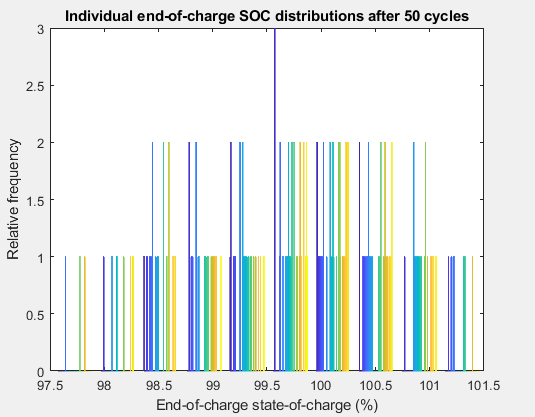01 Feb 2022
Explaining Cell Balancing
Q. How quickly do I have to balance a pack?
A. A pack must be balanced as quickly as the pack becomes unbalanced.
But exactly how quick is that and what causes the imbalance in the first place?
Starting with what causes the cell imbalance in a battery we can then move on to working out how quickly we need to balance a battery pack.
The first reason for cell imbalance in a pack is the coulombic efficiency of the cells. Coulombic efficiency can be defined as the charge efficiency for this discussion and is often around about 99% for a Lithium-Ion cell. Not all cells are created equally, even in the same batch of cells. Charge efficiency varies from cell to cell and will also vary with cell temperature.
A second reason is that cells have a self-discharge rate that we can electrically describe as an internal self-discharge resistance. This self-discharge resistance decreases cell SOC over time and varies from cell to cell, with cell temperature, and SOC of the cell. The higher either SOC or temperatures are, the higher the self-discharge rate.
Temperature variations across a pack will cause reasons one and two above to be amplified. Not all cells will be the same temperature in a battery pack; some may be in the centre and therefore have warm cells around them increasing their ambient temperature. Some cells may also be close to loads or a charger which create heat. And to exasperate issues, passive balancing resistors that create heat will cause an imbalance in the cells nearby. Current sense resistors can cause the same temperature gradient problems.
Then we have the consumption of Lithium by side reactions such as solid-electrolyte-interphase (SEI) layer growth, this is irreversible capacity loss and happens during the life of the cell. Strain caused by volume changes (up to 10%) during dis/charge can cause cracking in particles that consume Lithium when new SEI layers have to be formed.
We can round up the list with variations in the leakage current of the protection circuit. In some of MI's small protection circuits this can be up to 50µA.
Things that do not affect cell balance for our definition are cell capacity and internal cell resistance. I will save why that is for another article.
Knowing these cell variation factors, let's work out how out of balance a battery may get. Simulation isn't the solution for every problem, but damn it is good for calculations like this.
I have written some code which takes a model of a Samsung cell in a 4S battery. The following random values were entered into the equations.
- Set random coulombic efficiency of 99.7% to 99.9%.
- Set random cell protection circuit leakage current of 40uA to 50uA, values taken from MIPCM-4SXP7A datasheet.
- Set random self-discharge resistance. This resistance changes with temperature and SOC.
- Set Random temperature across the battery between 20.5°C and 24.5°C
Fifty battery packs were cycled through fifty cycles between 25% and 100% SOC at 1C with a 12-hour rest after each charging phase.
To make the simulation relatable to a protection circuit we stock, I used the over-voltage protection parameter of 4.25V per cell from the MIPCM-4SXP7A and also a simple CCCV 16.8V charger. This will allow us to see how a simple protection circuit without individual cell SOC calculations allows over-charging of individual cells as the pack has ever-increasing disparate levels of SOC.

Figure 1 The SOC spread, in percent, after 50 cycles is 3.971716
As seen in the histogram above, almost 4% of SOC difference occurs.
What does this SOC spread mean to the battery pack? The spread of SOC equates to a reduction in the useable capacity of the battery, the lowest capacity cell limiting the energy available. Across the 50 batteries simulated, some have lost close to 4% of the capacity simply because there is no cell balancing. Add the normal degradation process due to the cycling of the battery and that is another ~4% loss. The histogram above also shows that some cells are being overcharged, a normal distribution would suggest up to half. The overcharged cells will degrade more quickly and increase the SOC spread, this was not simulated.
Back to the question of how quickly must a pack be balanced. 4% SOC difference in the 2.5A cell simulated is 100mA in cell capacity difference, over 50 cycles that is 2mA per cycle. If we use a simple protection circuit and we top balance, all of the balancing will happen during the constant voltage phase of the charge. If we make the assumption that 1 hour is spent in the CV stage of charge you can quickly see that a minimum of 2mA balancing current is required for this 4S 2.5Ah battery. If the battery spends less time in CV then an increased balance current is required.
Is cell balancing important for the longevity of a battery? Yes.
Is cell balancing essential for maximising battery energy? Yes.
Should you include cell balancing in every battery design? Yes.
How much cell current do you need for cell balancing? It depends on battery design, cell model, cell capacity, cell chemistry, usage patterns, temperature gradients across the pack and the protection circuit itself.
Is there a simple formula for this? No.
And as always, thanks for reading.
Robert Hoehne